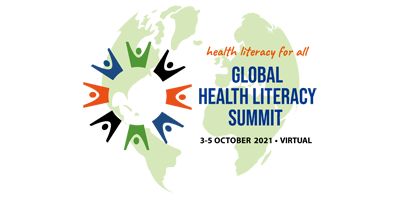Abstract Preview
Abstract
|
Title Co-designing health literacy responsive schools in Tasmania, Australia. |
|
Type Oral Presentation Only |
|
Theme Global Health Literacy Summit 2021 |
|
Topic Health literacy in schools and educational settings |
Authors
|
Main Author Rosie Nash1 |
|
Presenting Author Rosie Nash1 |
|
Co-Author Shandell Elmer2 Nenagh Kemp3 Martina Wyss4 Julie Roach5 Sue Costello6 |
Authors' Institution
|
Department / Institution / Country Public Health, College of Health & Medicine / The University of Tasmania / Australia1 Global Health and Equity. Faculty Arts, Health & Design / Swinburne University / Australia2 Psychology, College of Health & Medicine / The University Of Tasmania / Australia3 Sector Improvement and Innovation / Primary Health Tasmania / Australia4 Health Literacy Projects / Tasmanian Council of Social Services (TasCoSS) / Australia5 26TEN Strategy, Libraries Tasmania / Tasmanian Government / Australia6 |
|
Abstract Content (abstracts should be written in Size 11 font, Arial font style) Introduction/Background/Problem To ensure health equity, health services and community organisations must respond to the health literacy needs of everyone who accesses their services. Health literacy has been recognised as a social determinant in its own right that relies on interactions between the provider, individual and their wider community. Globally, organisational health literacy, health literate environments and health literacy responsiveness have been attracting increased attention. However, this is the first time that the health literacy responsiveness of schools themselves has been measured. Description of Objectives/Methods/Intervention Teachers at five participating schools completed the HeLLOTas (Health Literacy Learning Organisations, Tasmania) self-assessment checklist. They did so before and after participating in HealthLit4Kids. HealthLit4Kids aims to improve the health literacy of teachers, children and their communities. The HeLLOTas checklist required respondent to rate 77 items across six domains. In its completion (in groups), it supported teachers to develop a shared understanding of the “domains” of a health literate organisation. It also provided a measure to determine each school’s health literacy responsiveness. Results (effects/impact/changes) Although the differences between the pre- and post-intervention ratings were not large, they were in a positive direction for all six domains. A repeated-measures analysis of variance confirmed that overall ratings increased significantly from pre- to post-intervention, F (1, 4) = 83.9, p < .001, ƞ2 = .99. Supporting qualitative comments from the teachers were used to identify themes. Discussions/Conclusions/Lessons learned Teachers worked together to complete the checklist and discuss the six domains. This proved to be a useful education strategy capable of increasing awareness of the importance of schools becoming health-literacy responsive. Within our wider evaluation matrix, this data confirms that the HealthLit4Kids program can positively improve a school’s health literacy responsiveness. Further, teacher comments highlighted that the language in the tool was more suited to health than those working in the education sector. This requires consideration from a usability point of view. Teacher comments will inform the design of a guide for schools to support the use of an existing tool or inform the development of an organisational health literacy tool specific for schools. |
Requires Audio or Video system for Presentation?: Yes
